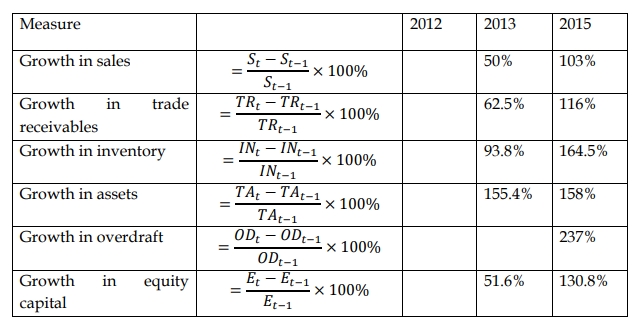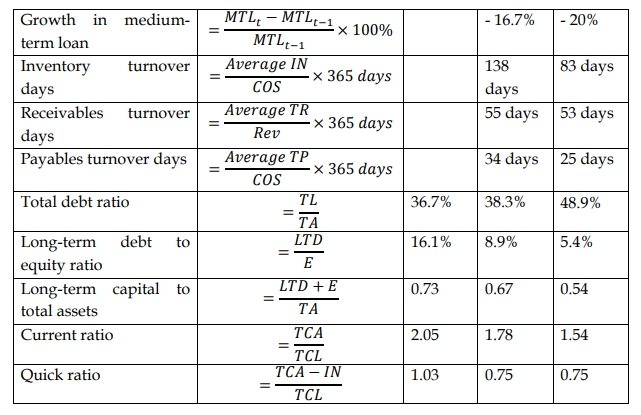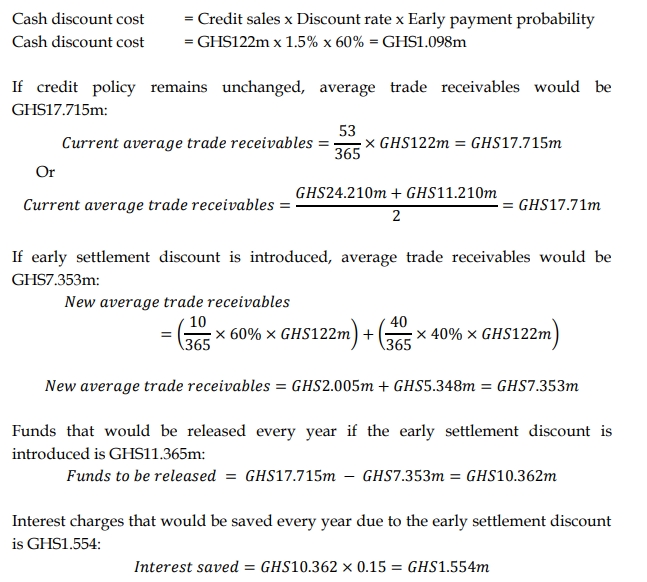- 20 Marks
Question
XYZ Ltd is a leading producer of mineral water in Ghana. The company sells all of its output to wholesalers on credit terms net 40. The company’s collection policy is somewhat relaxed, and so the receivables turnover days are currently 53 days. This fairly liberal credit policy has resulted in significant increases in sales revenue in recent years. However, the company has been facing cash flow problems as a significant number of customers take longer than the credit period to settle their accounts. The company typically falls on overdraft facilities from its bankers when it fails to generate adequate cash flows from operations to meet working capital requirements. The average cost of the overdraft facilities is 15% per annum.
Last week, the management team met and discussed the company’s cash flow and liquidity problems with a view to finding solutions to the problems. In that meeting, two proposals were offered to help solve the problems:
Proposal 1: Introduce an early settlement discount of 1.5% on accounts that are settled within 10 days of invoice while the current credit period is maintained. It is estimated that 60% of accounts will be paid within the discount period.
Proposal 2: Switch from financing working capital requirements using the bank overdraft facilities at 15% interest to financing working capital requirements using suppliers’ trade credit. Suppliers are willing to supply on credit terms 1/10, net 40.
Set out below are the company’s income statement and statement of financial position for the past three years.
Income statement for the year ended 31st December
| 2012 | 2013 | 2014 | |
|---|---|---|---|
| Revenue | 40,000 | 60,000 | 122,000 |
| Cost of sales | (15,000) | (31,000) | (90,000) |
| Gross profit | 25,000 | 29,000 | 32,000 |
| Selling and administrative expenses | (11,000) | (13,000) | (17,500) |
| Operating profit | 14,000 | 16,000 | 14,500 |
Statement of financial position as at 31st December
| 2012 | 2013 | 2014 | |
|---|---|---|---|
| Noncurrent assets: | |||
| Property, plant and equipment | 13,400 | 19,000 | 22,500 |
| Current assets: | |||
| Inventory | 8,000 | 15,500 | 25,500 |
| Trade receivables | 6,900 | 11,210 | 24,210 |
| Cash | 1,110 | – | – |
| Total current assets | 16,010 | 26,710 | 49,710 |
| Total assets | 29,410 | 45,710 | 72,210 |
| Equity: | |||
| Stated capital | 100 | 100 | 100 |
| Income surplus | 18,510 | 28,110 | 36,810 |
| Shareholders’ equity | 18,610 | 28,210 | 36,910 |
| Non-current liabilities: | |||
| Medium-term loan | 3,000 | 2,500 | 2,000 |
| Current liabilities: | |||
| Trade payables | 2,200 | 3,500 | 8,600 |
| Dividend payable | 5,600 | 6,400 | 7,500 |
| Bank overdraft | – | 5,100 | 17,200 |
| Total current liabilities | 7,800 | 15,000 | 33,300 |
| Total liabilities | 10,800 | 17,500 | 35,300 |
| Total equity and liabilities | 29,410 | 45,710 | 72,210 |
Required:
a) Considering the background information and financial data provided above, would you conclude that XYZ Ltd is experiencing overtrading? Explain with relevant computations. (9 marks)
b) Appraise the proposal for early settlement discount (i.e. Proposal 1) and advise on whether it should be accepted for implementation or not. Your appraisal should focus on how the discount policy will influence the company’s profitability. Show all relevant computations. (5 marks)
c) Appraise the proposal to switch from financing working capital needs using bank overdraft to using suppliers’ trade credit, and advise management accordingly. Show all relevant computations. (3 marks)
d) Assuming XYZ Ltd cannot raise additional funds from external sources such as borrowing and new share offers, suggest to management three steps they can take to ease the cash shortages the company is facing. (3 marks)
Answer
a) Is XYZ Ltd Overtrading?
To conclude whether the company is overtrading, candidates are expected to identify the symptoms of overtrading and diagnose the company’s situation from the information given.
Overtrading occurs when a company tries to do too much too quickly with too little long-term capital. Typically, a company that is overtrading would exhibit the following symptoms:
- Rapid growth in sales revenue.
- Rapid growth in current assets, particularly inventory and receivables.
- Small growth in equity capital, which may be through reinvestment of profit.
- Significant increases in debt ratios such as total debt ratio and debt-to-equity ratio.
- Significant decreases in liquidity ratios such as current ratio and quick ratio.
Based on the financial data:
- Sales revenue increased by 50% in 2013 and 103% in 2014.
- The company’s liquidity ratios decreased, with the current ratio dropping from 2.05:1 in 2012 to 1.54:1 in 2014.
- There is a significant increase in bank overdraft, rising by 237% in 2014.
There has been significant growth in sales revenue (50% in 2013 and 103% in 2014). This
is accompanied by significant growth in current assets, particularly receivables and
inventory. However, receivables turnover days and inventory turnover days have both
shortened from 55 to 53 days and from 138 to 83 days respectively. What is more, the
payables turnover days has shortened significantly from 34 days to 25 days due to the
increased use of bank overdraft in financing working capital needs. Bank overdraft
increased by a whopping 237% in 2014.
The company’s liquidity ratios kept dropping over the three years under review. The
current ratio dropped from 2.05:1 in 2012 to just 1.54:1 in 2014 while the quick ratio
dropped from 1.03:1 in 2012 to 0.75:1 in 2014. Besides, the ratio of long-term capital to
total assets kept reducing over the same periods. Long-term capital that stood at 73% of
total assets in 2012 had dropped to 54% of total assets. The decreases in liquidity ratio is
due to the significant increase in current liabilities, mainly due to the high increment in
bank overdraft financing. The growth in long-term capital is due to reinvestment of
profits as stated capital stood the same and medium-term loan was being amortised
over the period. These suggest that the company is financing most of the rapid growth
in sales with short-term funds rather than long-term capital.
Sales revenue is increasing rapidly, liquidity ratios are falling, long-term capital ratio is
falling, and there is significant increase in bank overdraft. On the face of it, one would
concluded that the company is overtrading. However, the ratio of long-term capital is
not yet too low to permit the conclusion that the company is trying to do too much too
quickly with too little long-term capital. If the current trends in long-term capital ratio,
sales growth, and liquidity ratios continue in the future, the company might experience
overtrading in the near future.


On the face of it, one could conclude that XYZ Ltd is overtrading. However, the ratio of long-term capital is not yet too low to make that conclusion definitive.
(b) Introduction of early settlement discount policy
Under current policy:
Candidates are expected to match the cost of the early discount policy against the
benefit of it. The policy change is worthwhile when the benefit, measured in terms of
annual interest savings, exceeds the cost, measured in terms of the cash discount that
would be given
Current credit sales = GHS122 million
Current credit period = 40 days
Receivables turnover days = 53 days
Trade receivables, 2014 = GHS24.210 million
Trade receivables, 2013 = GHS11.210 million
Under discount policy:
Credit sales = GHS122 million (assumed to be kept at recent
sales level)
Credit period = 40 days
Discount period = 10 days
Discount rate = 1.5%
Early payment probability =60%
Other relevant data:
Financing cost = 15%

Summary:
Benefit of new discount policy: Interest saved every year = 1.554
Cost of new discount policy: Cash discount allowed every year = 1.098
Net benefit of new discount policy = 0.456
Conclusion:
If the early settlement discount is introduced and 60% of accounts are settled early to
take the discount, the company’s profit will increase by GHS0.456m every year.
Therefore, management should accept the early settlement discount proposal for
implementation.
(c) Switch from financing working capital needs with bank overdraft to financing with
trade credit
If the company continues to finance working capital needs with bank overdraft, the
annual financing cost would be 15%.
If the company finances working capital needs with suppliers trade credit the
annual financing cost would be 12.3% (assuming simple interest):

Conclusion:
Since the cost of financing with suppliers’ trade credit is lower than the cost of
financing with the overdraft facilities, the company should discard its current
working capital financing method and finance with trade credit.
Note:
Full credit should be given to candidates who estimate the cost of trade credit
based on compound interest:


d) Easing Cash Shortages
- Postpone capital investments.
- Accelerate collection from customers by offering incentives.
- Reduce investment in inventory to minimize funds tied up in working capital.
- Postpone dividend payments.
- Negotiate with creditors for more favourable payment terms.
- Reverse past investment decisions by selling assets previously acquired but
are surplus to the company’s needs, or producing negative or lower returns.
Even assets that are needed can be sold and leased back.
- Tags: Early Settlement, Overtrading, Trade Credit
- Level: Level 2
- Topic: Working Capital Management
- Series: MAY 2016
- Uploader: Joseph
